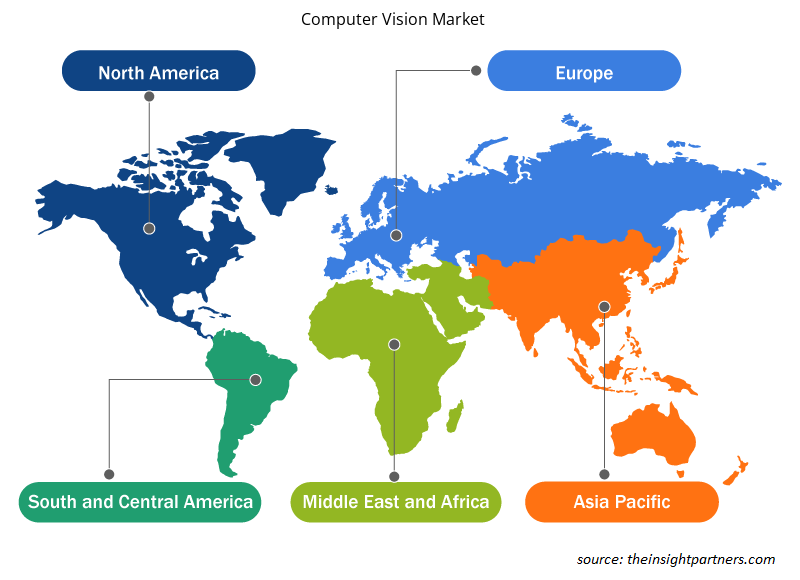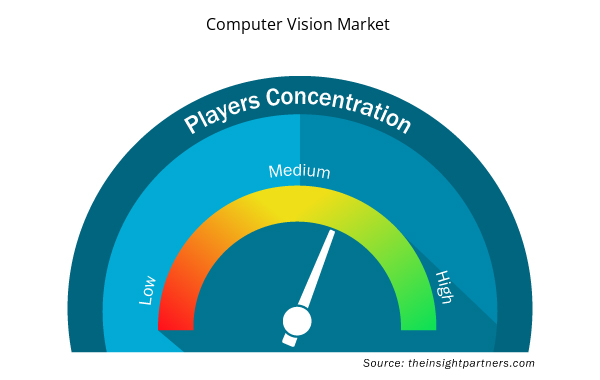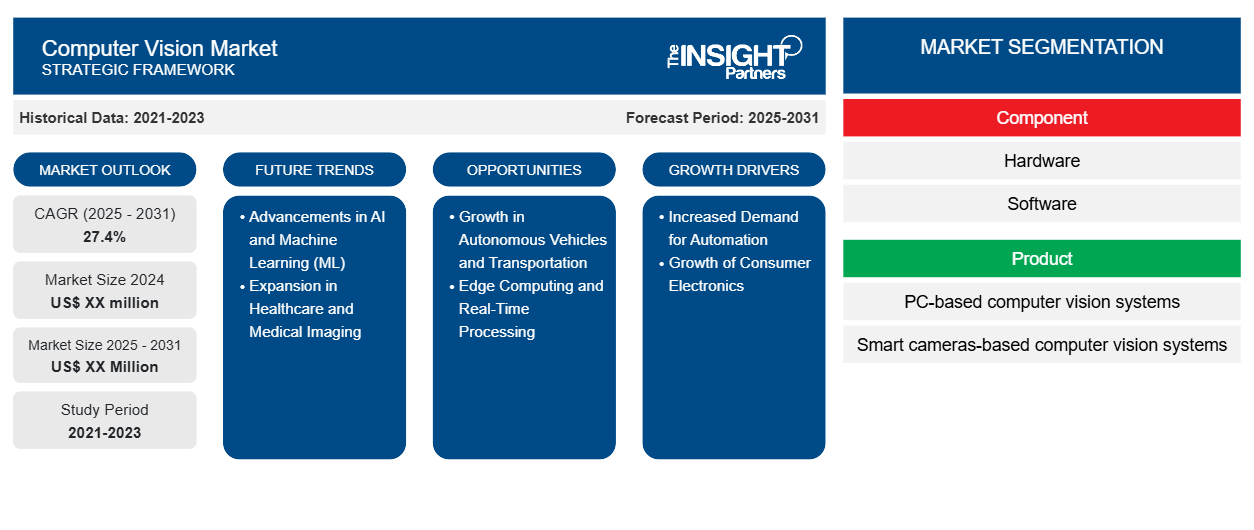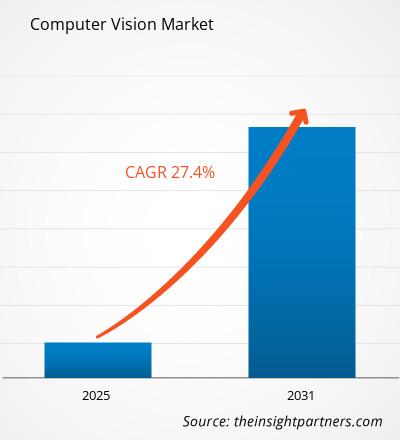Es wird erwartet, dass der Computer Vision-Markt von 2023 bis 2031 eine durchschnittliche jährliche Wachstumsrate (CAGR) von 27,4 % verzeichnet, wobei die Marktgröße von XX Millionen US-Dollar im Jahr 2023 auf XX Millionen US-Dollar im Jahr 2031 anwachsen wird.
Der Bericht ist segmentiert nach Komponente (Hardware, Software); Produkt (PC-basierte Computer-Vision-Systeme, auf Smart-Kameras basierende Computer-Vision-Systeme); Anwendung (Qualitätssicherung und Inspektion, Positionierung und Führung, Messung, Identifikation, vorausschauende Wartung); Vertikal (Industriell vertikal, Nicht-Industriell vertikal). Die globale Analyse ist weiter auf regionaler Ebene und in die wichtigsten Länder unterteilt. Der Bericht bietet den Wert in USD für die oben genannte Analyse und die Segmente.
Zweck des Berichts
Der Bericht Computer Vision Market von The Insight Partners zielt darauf ab, die aktuelle Landschaft und das zukünftige Wachstum sowie die wichtigsten treibenden Faktoren, Herausforderungen und Chancen zu beschreiben. Dies wird verschiedenen Geschäftspartnern Einblicke geben, wie zum Beispiel:
- Technologieanbieter/-hersteller: Um die sich entwickelnde Marktdynamik zu verstehen und die potenziellen Wachstumschancen zu kennen, damit sie fundierte strategische Entscheidungen treffen können.
- Investoren: Durchführung einer umfassenden Trendanalyse hinsichtlich der Marktwachstumsrate, der finanziellen Marktprognosen und der Chancen entlang der Wertschöpfungskette.
- Regulierungsbehörden: Zur Regulierung von Richtlinien und Überwachungsaktivitäten auf dem Markt mit dem Ziel, Missbrauch zu minimieren, das Vertrauen der Anleger zu bewahren und die Integrität und Stabilität des Marktes aufrechtzuerhalten.
Computer Vision Marktsegmentierung
Komponente
- Hardware
- Software
Produkt
- PC-basierte Computer Vision Systeme
- Auf intelligenten Kameras basierende Computer-Vision-Systeme
Anwendung
- Qualitätssicherung und Inspektion
- Positionierung und Führung
- Messung
- Identifikation
- Vorausschauende Wartung
Vertikal
- Industrielle Vertikale
- Nicht-industrielle Vertikale
Vertikal
- Industrielle Vertikale
- Nicht-industrielle Vertikale
Passen Sie diesen Bericht Ihren Anforderungen an
Sie erhalten kostenlos individuelle Anpassungen an jedem Bericht, einschließlich Teilen dieses Berichts oder einer Analyse auf Länderebene, eines Excel-Datenpakets sowie tolle Angebote und Rabatte für Start-ups und Universitäten.
- Holen Sie sich die wichtigsten Markttrends aus diesem Bericht.Dieses KOSTENLOSE Beispiel umfasst eine Datenanalyse von Markttrends bis hin zu Schätzungen und Prognosen.
Wachstumstreiber auf dem Computer Vision-Markt
- Erhöhte Nachfrage nach Automatisierung: Der Trend zur Automatisierung in der Fertigung und in der Industrie hat zu einer verstärkten Nutzung von Computer Vision für Aufgaben wie Qualitätskontrolle, vorausschauende Wartung und Roboterautomatisierung geführt. Einzelhändler nutzen Computer Vision für die Bestandsverwaltung, die Regalüberwachung und sogar in kassenlosen Geschäften. E-Commerce-Plattformen nutzen visuelle Such- und Empfehlungssysteme, um das Einkaufserlebnis zu verbessern.
- Wachstum der Unterhaltungselektronik: Smartphones mit fortschrittlichen Kamerafunktionen, einschließlich Gesichtserkennung und Augmented Reality (AR), haben die Nachfrage nach Computer-Vision-Technologien angekurbelt. Innovationen in den Bereichen mobile Fotografie, Videoverarbeitung und AR-Apps basieren stark auf Computer-Vision.
Zukünftige Trends auf dem Computer Vision-Markt
- Fortschritte in KI und maschinellem Lernen (ML): Die Entwicklung von Deep-Learning-Techniken, insbesondere Convolutional Neural Networks (CNNs), hat die Fähigkeiten der Computervision deutlich verbessert. Diese Algorithmen ermöglichen es Maschinen, visuelle Daten mit beispielloser Genauigkeit zu interpretieren und zu verstehen.
- Expansion im Gesundheitswesen und in der medizinischen Bildgebung: Computer Vision bietet bedeutende Chancen im Gesundheitswesen, insbesondere in der medizinischen Bildgebung, Diagnostik und Patientenüberwachung. Computer Vision-Algorithmen werden zunehmend zur Analyse medizinischer Bilder wie Röntgenaufnahmen, MRTs und CT-Scans eingesetzt, um Anomalien zu erkennen, bei der Frühdiagnose von Krankheiten zu helfen und die Behandlungsgenauigkeit zu verbessern. Die zunehmende Nutzung der Telemedizin, gepaart mit dem Bedarf an effizienter und genauer Diagnostik, bietet eine wachsende Chance für Computer Vision, die Gesundheitsbranche zu revolutionieren.
Marktchancen für Computer Vision
- Wachstum bei autonomen Fahrzeugen und Transport: Der Aufstieg autonomer Fahrzeuge, Drohnen und Robotersysteme ist eine große Wachstumschance für den Computer-Vision-Markt. Diese Systeme verlassen sich auf Computer-Vision, um ihre Umgebung zu verstehen und zu navigieren, Verkehrsschilder zu interpretieren, Fußgänger zu erkennen und Sicherheit zu gewährleisten. Da die Branche der autonomen Fahrzeuge immer reifer wird und Drohnenlieferungen und autonome Logistiklösungen an Bedeutung gewinnen, wird die Nachfrage nach Computer-Vision-Technologien, die Objekterkennung, Kartierung und Navigation in Echtzeit unterstützen, deutlich steigen.
- Edge Computing und Echtzeitverarbeitung: Ein wachsender Trend auf dem Computer-Vision-Markt ist die Verlagerung hin zum Edge Computing, bei dem Bildverarbeitung und -analyse direkt auf lokalen Geräten durchgeführt werden, anstatt an zentrale Server gesendet zu werden. Dies ermöglicht schnellere Entscheidungen in Echtzeit und reduziert die Latenz, was bei Anwendungen wie autonomen Fahrzeugen, Industrierobotern und Sicherheitsüberwachung von entscheidender Bedeutung ist. Edge-Geräte mit integrierten Computer-Vision-Funktionen ermöglichen eine effizientere Datenverarbeitung und verbessern die allgemeine Reaktionsfähigkeit KI-gesteuerter Systeme.
Regionale Einblicke in den Computer Vision-Markt
Die regionalen Trends und Faktoren, die den Computer Vision-Markt im Prognosezeitraum beeinflussen, wurden von den Analysten von Insight Partners ausführlich erläutert. In diesem Abschnitt werden auch Computer Vision-Marktsegmente und -Geografie in Nordamerika, Europa, im asiatisch-pazifischen Raum, im Nahen Osten und Afrika sowie in Süd- und Mittelamerika erörtert.

- Holen Sie sich regionale Daten zum Computer Vision-Markt
Umfang des Computer Vision-Marktberichts
| Berichtsattribut | Details |
|---|---|
| Marktgröße im Jahr 2023 | XX Millionen US-Dollar |
| Marktgröße bis 2031 | XX Millionen US-Dollar |
| Globale CAGR (2023 - 2031) | 27,4 % |
| Historische Daten | 2021-2022 |
| Prognosezeitraum | 2024–2031 |
| Abgedeckte Segmente | Nach Komponente
|
| Abgedeckte Regionen und Länder | Nordamerika
|
| Marktführer und wichtige Unternehmensprofile |
|
Dichte der Marktteilnehmer im Bereich Computer Vision: Die Auswirkungen auf die Geschäftsdynamik verstehen
Der Markt für Computer Vision wächst rasant, angetrieben durch die steigende Nachfrage der Endnutzer aufgrund von Faktoren wie sich entwickelnden Verbraucherpräferenzen, technologischen Fortschritten und einem größeren Bewusstsein für die Vorteile des Produkts. Mit steigender Nachfrage erweitern Unternehmen ihr Angebot, entwickeln Innovationen, um die Bedürfnisse der Verbraucher zu erfüllen, und nutzen neue Trends, was das Marktwachstum weiter ankurbelt.
Die Marktteilnehmerdichte bezieht sich auf die Verteilung der Firmen oder Unternehmen, die in einem bestimmten Markt oder einer bestimmten Branche tätig sind. Sie gibt an, wie viele Wettbewerber (Marktteilnehmer) in einem bestimmten Marktraum im Verhältnis zu seiner Größe oder seinem gesamten Marktwert präsent sind.
Die wichtigsten auf dem Computer Vision-Markt tätigen Unternehmen sind:
- Cognex Corporation
- Basler
- Omron Corporation
- KEYENCE CORPORATION
- Nationale Instrumente
Haftungsausschluss : Die oben aufgeführten Unternehmen sind nicht in einer bestimmten Reihenfolge aufgeführt.

- Überblick über die wichtigsten Akteure auf dem Computer Vision-Markt
Wichtige Verkaufsargumente
- Umfassende Abdeckung: Der Bericht deckt die Analyse von Produkten, Diensten, Typen und Endbenutzern des Computer Vision-Marktes umfassend ab und bietet einen ganzheitlichen Überblick.
- Expertenanalyse: Der Bericht basiert auf dem umfassenden Verständnis von Branchenexperten und Analysten.
- Aktuelle Informationen: Der Bericht stellt durch die Abdeckung aktueller Informationen und Datentrends Geschäftsrelevanz sicher.
- Anpassungsoptionen: Dieser Bericht kann angepasst werden, um den spezifischen Kundenanforderungen gerecht zu werden und die Geschäftsstrategien optimal anzupassen.
Der Forschungsbericht zum Computer Vision-Markt kann daher dabei helfen, die Branchensituation und Wachstumsaussichten zu entschlüsseln und zu verstehen. Obwohl es einige berechtigte Bedenken geben kann, überwiegen die allgemeinen Vorteile dieses Berichts tendenziell die Nachteile.
- Historische Analyse (2 Jahre), Basisjahr, Prognose (7 Jahre) mit CAGR
- PEST- und SWOT-Analyse
- Marktgröße Wert/Volumen – Global, Regional, Land
- Branche und Wettbewerbsumfeld
- Excel-Datensatz


- Trade Promotion Management Software Market
- Online Exam Proctoring Market
- Tortilla Market
- Artificial Intelligence in Defense Market
- Hair Extensions Market
- Parking Management Market
- Aquaculture Market
- Drain Cleaning Equipment Market
- Portable Power Station Market
- Lyophilization Services for Biopharmaceuticals Market

Report Coverage
Revenue forecast, Company Analysis, Industry landscape, Growth factors, and Trends

Segment Covered
This text is related
to segments covered.

Regional Scope
North America, Europe, Asia Pacific, Middle East & Africa, South & Central America

Country Scope
This text is related
to country scope.
Häufig gestellte Fragen
Some of the customization options available based on the request are an additional 3-5 company profiles and country-specific analysis of 3-5 countries of your choice. Customizations are to be requested/discussed before making final order confirmation# as our team would review the same and check the feasibility
The report can be delivered in PDF/PPT format; we can also share excel dataset based on the request
Advancements in AI and Machine Learning (ML) is anticipated to play a significant role in the global Computer Vision market in the coming years
The major factors driving the Computer Vision market are Increased Demand for Automation and Growth of Consumer Electronics.
The Computer Vision Market is estimated to witness a CAGR of 27.4% from 2023 to 2031
Trends and growth analysis reports related to Electronics and Semiconductor : READ MORE..
1. Cognex Corporation
2. Basler
3. Omron Corporation
4. KEYENCE CORPORATION
5. National Instruments
6. Sony Corporation
7. Teledyne Technologies, Inc.
8. Allied Vision Technologies
9. Texas Instruments, Inc.
10. Intel Corporation
The Insight Partners performs research in 4 major stages: Data Collection & Secondary Research, Primary Research, Data Analysis and Data Triangulation & Final Review.
- Data Collection and Secondary Research:
As a market research and consulting firm operating from a decade, we have published and advised several client across the globe. First step for any study will start with an assessment of currently available data and insights from existing reports. Further, historical and current market information is collected from Investor Presentations, Annual Reports, SEC Filings, etc., and other information related to company’s performance and market positioning are gathered from Paid Databases (Factiva, Hoovers, and Reuters) and various other publications available in public domain.
Several associations trade associates, technical forums, institutes, societies and organization are accessed to gain technical as well as market related insights through their publications such as research papers, blogs and press releases related to the studies are referred to get cues about the market. Further, white papers, journals, magazines, and other news articles published in last 3 years are scrutinized and analyzed to understand the current market trends.
- Primary Research:
The primarily interview analysis comprise of data obtained from industry participants interview and answers to survey questions gathered by in-house primary team.
For primary research, interviews are conducted with industry experts/CEOs/Marketing Managers/VPs/Subject Matter Experts from both demand and supply side to get a 360-degree view of the market. The primary team conducts several interviews based on the complexity of the markets to understand the various market trends and dynamics which makes research more credible and precise.
A typical research interview fulfils the following functions:
- Provides first-hand information on the market size, market trends, growth trends, competitive landscape, and outlook
- Validates and strengthens in-house secondary research findings
- Develops the analysis team’s expertise and market understanding
Primary research involves email interactions and telephone interviews for each market, category, segment, and sub-segment across geographies. The participants who typically take part in such a process include, but are not limited to:
- Industry participants: VPs, business development managers, market intelligence managers and national sales managers
- Outside experts: Valuation experts, research analysts and key opinion leaders specializing in the electronics and semiconductor industry.
Below is the breakup of our primary respondents by company, designation, and region:

Once we receive the confirmation from primary research sources or primary respondents, we finalize the base year market estimation and forecast the data as per the macroeconomic and microeconomic factors assessed during data collection.
- Data Analysis:
Once data is validated through both secondary as well as primary respondents, we finalize the market estimations by hypothesis formulation and factor analysis at regional and country level.
- Macro-Economic Factor Analysis:
We analyse macroeconomic indicators such the gross domestic product (GDP), increase in the demand for goods and services across industries, technological advancement, regional economic growth, governmental policies, the influence of COVID-19, PEST analysis, and other aspects. This analysis aids in setting benchmarks for various nations/regions and approximating market splits. Additionally, the general trend of the aforementioned components aid in determining the market's development possibilities.
- Country Level Data:
Various factors that are especially aligned to the country are taken into account to determine the market size for a certain area and country, including the presence of vendors, such as headquarters and offices, the country's GDP, demand patterns, and industry growth. To comprehend the market dynamics for the nation, a number of growth variables, inhibitors, application areas, and current market trends are researched. The aforementioned elements aid in determining the country's overall market's growth potential.
- Company Profile:
The “Table of Contents” is formulated by listing and analyzing more than 25 - 30 companies operating in the market ecosystem across geographies. However, we profile only 10 companies as a standard practice in our syndicate reports. These 10 companies comprise leading, emerging, and regional players. Nonetheless, our analysis is not restricted to the 10 listed companies, we also analyze other companies present in the market to develop a holistic view and understand the prevailing trends. The “Company Profiles” section in the report covers key facts, business description, products & services, financial information, SWOT analysis, and key developments. The financial information presented is extracted from the annual reports and official documents of the publicly listed companies. Upon collecting the information for the sections of respective companies, we verify them via various primary sources and then compile the data in respective company profiles. The company level information helps us in deriving the base number as well as in forecasting the market size.
- Developing Base Number:
Aggregation of sales statistics (2020-2022) and macro-economic factor, and other secondary and primary research insights are utilized to arrive at base number and related market shares for 2022. The data gaps are identified in this step and relevant market data is analyzed, collected from paid primary interviews or databases. On finalizing the base year market size, forecasts are developed on the basis of macro-economic, industry and market growth factors and company level analysis.
- Data Triangulation and Final Review:
The market findings and base year market size calculations are validated from supply as well as demand side. Demand side validations are based on macro-economic factor analysis and benchmarks for respective regions and countries. In case of supply side validations, revenues of major companies are estimated (in case not available) based on industry benchmark, approximate number of employees, product portfolio, and primary interviews revenues are gathered. Further revenue from target product/service segment is assessed to avoid overshooting of market statistics. In case of heavy deviations between supply and demand side values, all thes steps are repeated to achieve synchronization.
We follow an iterative model, wherein we share our research findings with Subject Matter Experts (SME’s) and Key Opinion Leaders (KOLs) until consensus view of the market is not formulated – this model negates any drastic deviation in the opinions of experts. Only validated and universally acceptable research findings are quoted in our reports.
We have important check points that we use to validate our research findings – which we call – data triangulation, where we validate the information, we generate from secondary sources with primary interviews and then we re-validate with our internal data bases and Subject matter experts. This comprehensive model enables us to deliver high quality, reliable data in shortest possible time.


 Holen Sie sich ein kostenloses Muster für diesen Bericht
Holen Sie sich ein kostenloses Muster für diesen Bericht